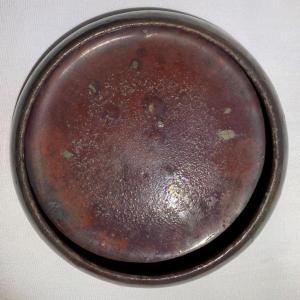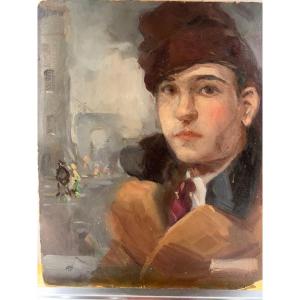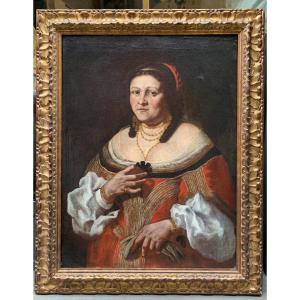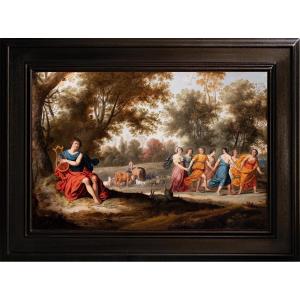Period: Late 16th Century
Technique: Oil on Wooden Panel
This painting, executed using the ancient technique of oil on wooden panel, depicts the legendary scene in which Hercules defeats Cacus. According to the legend, Cacus was a monstrous giant who breathed fire. The son of Vulcan, Cacus lived in a cave on the Aventine Hill and terrorized the local population by stealing cattle and hiding his tracks with fire and smoke. Hercules ultimately killed him as part of his Twelve Labors, discovering him while he was stealing the cattle of Geryon.
The depiction serves as an allegory of politics, with Hercules symbolizing the triumph of good over evil.
The background landscape is particularly notable: a city located on the bank of a river, with a fortress perched atop a rock. To the left, a cave can be seen, with cows and Cacus.
The painting shows traces of an Italian red wax seal on the back, which features an inscription dating from before the unification of Italy, thus before the mid-19th century. It is remarkable how this subject was popular in the 16th century and used for political purposes. In Florence, the Labors of Hercules were often depicted to draw comparisons between the hero and Cosimo I de' Medici. Similarly, in Spain, during the same period, tapestries depicting the Labors of Hercules appeared, alluding to the Habsburgs.
The most likely iconographic source for this painting might be a tapestry, a drawing, or a print derived from it. The figures are dressed in ancient Roman attire, are very muscular, and the landscape is rendered in great detail. The Roman sandals are described with meticulous care.
The painting is well-preserved, with only a few scratches that do not affect the overall condition of the piece. Instead of a frame, there is an ancient support structure with two crossed wrought iron rods for hanging the painting. This artwork is an example of historical art, rich in symbolism and detail, capturing the essence of the legend of Hercules and Cacus and the political context of the time.
The myth of Hercules was used to legitimize and glorify political power, highlighting virtues such as strength, courage, and endurance, which were particularly relevant for rulers who sought to be seen as classical heroes.
The Labors of Hercules were a highly popular theme during the Renaissance, and paintings depicting them could have been commissioned or used to showcase the strength and legitimacy of the patron's power.
Such artworks were often employed for purposes of ostentation and decoration in prestigious settings, emphasizing heroic virtues and the authority of political power.















































 Le Magazine de PROANTIC
Le Magazine de PROANTIC TRÉSORS Magazine
TRÉSORS Magazine Rivista Artiquariato
Rivista Artiquariato